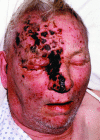Herpes zoster (shingles) and postherpetic neuralgia
- PMID: 19252116
- PMCID: PMC2664599
- DOI: 10.4065/84.3.274
Herpes zoster (shingles) and postherpetic neuralgia
Abstract
Herpes zoster (HZ), commonly called shingles, is a distinctive syndrome caused by reactivation of varicella zoster virus (VZV). This reactivation occurs when immunity to VZV declines because of aging or immunosuppression. Herpes zoster can occur at any age but most commonly affects the elderly population. Postherpetic neuralgia (PHN), defined as pain persisting more than 3 months after the rash has healed, is a debilitating and difficult to manage consequence of HZ. The diagnosis of HZ is usually made clinically on the basis of the characteristic appearance of the rash. Early recognition and treatment can reduce acute symptoms and may also reduce PHN. A live, attenuated vaccine aimed at boosting immunity to VZV and reducing the risk of HZ is now available and is recommended for adults older than 60 years. The vaccine has been shown to reduce significantly the incidence of both HZ and PHN. The vaccine is well tolerated, with minor local injection site reactions being the most common adverse event. This review focuses on the clinical manifestations and treatment of HZ and PHN, as well as the appropriate use of the HZ vaccine.
Figures


Comment in
-
Herpes zoster: query and concern.Mayo Clin Proc. 2009 Jul;84(7):663; author reply 663-4. doi: 10.1016/S0025-6196(11)60757-X. Mayo Clin Proc. 2009. PMID: 19567720 Free PMC article. No abstract available.
References
-
- Arvin A.Aging, immunity, and the varicella-zoster virus. N Engl J Med. 2005;352(22):2266-2267 - PubMed
-
- Harpaz R,, Ortega-Sanchez IR, Seward JF. Prevention of herpes zoster: recommendations of the Advisory Committee on Immunization Practices (ACIP) [published correction appears in MMWR Recomm Rep. 2008;57(28): 779] MMWR Recomm Rep. 2008;57(RR-5):1-30 - PubMed
-
- Yawn BP, Saddier P, Wollan P, St Sauver JL, Kurland MJ, Sy LS. A population-based study of the incidence and complication rates of herpes zoster before zoster vaccine introduction [published correction appears in Mayo Clin Proc. 2008;83(2):255] Mayo Clin Proc. 2007November;82(11):1341-1349 - PubMed
-
- Gnann JW., Jr.Vaccination to prevent herpes zoster in older adults. J Pain. 2008;9(1)(suppl 1):S31-S36 - PubMed
-
- Liesegang TJ. Herpes zoster ophthalmicus natural history, risk factors, clinical presentation, and morbidity. Ophthalmology 2008;115(2)(suppl):S3-S12 - PubMed
Publication types
MeSH terms
Substances
LinkOut - more resources
Full Text Sources
Other Literature Sources
Medical

